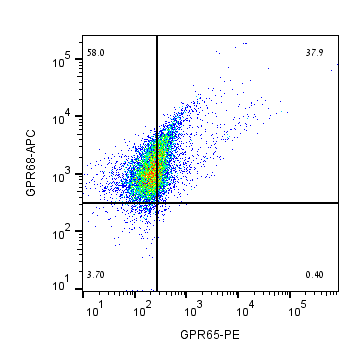Overview
- Peptide (C)DYTWNKDNWTFSP, corresponding to amino acid residues 72 - 84 of human GPR65 (Accession Q8IYL9). 1st extracellular loop.

 Cell surface detection of GPR65 in live intact mouse EL4 T-cell lymphoma cells:___ Cells.
Cell surface detection of GPR65 in live intact mouse EL4 T-cell lymphoma cells:___ Cells.
___ Cells + rabbit IgG isotype control-PE.
___ Cells + Anti-GPR65 (TDAG8) (extracellular)-PE Antibody (#AGR-043-PE), (5 µg). Cell surface detection of GPR65 in live intact human THP-1 monocytic leukemia cells:___ Cells.
Cell surface detection of GPR65 in live intact human THP-1 monocytic leukemia cells:___ Cells.
___ Cells + rabbit IgG isotype control-PE.
___ Cells + Anti-GPR65 (TDAG8) (extracellular)-PE Antibody (#AGR-043-PE), (5 µg). Multicolor flow cytometry with GPR65 and GPR68Human THP-1 monocytic leukemia cell line was labeled by adding Anti-GPR65 (TDAG8) (extracellular)-PE Antibody (#AGR-043-PE), (5µg) and Anti-GPR68 (OGR1) (extracellular)-APC Antibody (#AGR-042-APC), (5µg).
Multicolor flow cytometry with GPR65 and GPR68Human THP-1 monocytic leukemia cell line was labeled by adding Anti-GPR65 (TDAG8) (extracellular)-PE Antibody (#AGR-043-PE), (5µg) and Anti-GPR68 (OGR1) (extracellular)-APC Antibody (#AGR-042-APC), (5µg).
- Justus, C.R. et al. (2013) Front. Physiol. 4, 354.
- Justus, C.R. et al. (2017) J. Transl. Med. 15, 204.
GPR65, also called TDAG8 (T-cell death associated gene 8 protein), is a pH-sensing G-protein coupled receptor (GPCR) activated by acidic extracellular pH through the protonation of several histidine residues in the receptor’s sequence. GPR65 is involved in cancer cell metastasis and proliferation, immune cell function, inflammation, and blood vessel formation1.
Human GPR65 gene has been mapped to a location that is associated with T cell lymphoma and leukemia abnormalities.
GPR65 is primarily expressed in immune cells and leukocyte-rich tissues such as circulating peripheral leukocytes, spleen, thymus, and tonsils. Expression is also detected pain relevant loci such as the dorsal root ganglia neurons and particularly small diameter neurons responsible for nociception1,2.
GPR65 has the ability to affect tumor development and growth. Overexpression of GPR65 in Lewis lung carcinoma cells increases tumor growth in mice and may facilitate resistance to acidosis-mediated cell death in vitro through protein kinase A (PKA) and ERK related pathways1.
Knockdown of GPR65 in NCI-H460 human non-small cell lung cancer cells decreases cell survival in acidic condition. Another study shows that activation of GPR65 by acidosis can promote evasion of cell apoptosis under glutamine starvation and its overexpression has been reported to transform immortalized mammary epithelial cells1.
Application key:
Species reactivity key:
Anti-GPR65 (TDAG8) (extracellular) Antibody (#AGR-043) is a highly specific antibody directed against an epitope of the human protein. The antibody can be used in western blot, immunohistochemistry, and live cell flow cytometry. It has been designed to recognize GPR65 from rat, mouse, and human samples.
Anti-GPR65 (TDAG8) (extracellular)-PE Antibody (#AGR-043-PE) is directly conjugated to Phycoerythrin (PE). This labeled antibody can be used in immunofluorescent applications such as direct flow cytometry and live cell imaging.
